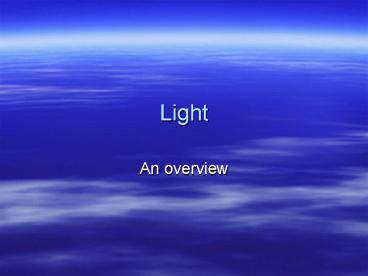Light - PowerPoint PPT Presentation
1 / 15
Title:
Light
Description:
In essence the light bounces off of an object that is flat and smooth. ... In essence the light bounces off of a irregularly shaped object that is not flat ... – PowerPoint PPT presentation
Number of Views:20
Avg rating:3.0/5.0
Title: Light
1
Light
- An overview
2
Ray Model of Light
- Assumes that light travels in a straight path
called a light ray
3
Reflection
- Regular reflection the incoming angle and
outgoing angle of light are equivalent. In
essence the light bounces off of an object that
is flat and smooth. - Diffuse reflection the incoming angle and
outgoing angle of light are different and
scatters the rays of light. In essence the light
bounces off of a irregularly shaped object that
is not flat or smooth
4
Reflection Types
5
Concave and Convex mirrors
- Concave mirror the surface of the mirror curves
inward and the rays of light reach what is said
to be a focal point - Convex mirror The surface of the mirror curves
outward. The rays of light get pushed away from
each other.
6
Concave / Convex Mirror
7
Refraction Of light
- Refraction is the bending of light due to a
change in its speed.
8
Converge / Diverge Lenses
9
Lenses
- A lens is a transparent material that refracts
light - Concave lens diverges or spreads out the rays of
light - Convex lens converges or brings together the
rays of light
10
Index of Refraction
- Is the comparison of the speed of light in air
with the speed of light in a certain material.
11
Color
- When light strikes any form of matter the light
can be transmitted, absorbed, or reflected. - White (natural) light is made out of the
following colors red, orange, yellow, green,
blue, indigo, violet - Discussion on why we see and how we see pg. 686
12
How are we able to see
- You see light through a series of steps that
involve the various parts of the eye and brain.
13
Steps of vision
- Light enters the eye through the pupil
- The amount of light that enters is controlled by
the iris - The cornea and the lens refract light to focus it
on the retina - The image is upside down
- The brain interprets this image
- The nervous cells on the retina are called rods
and cones
14
Rods and Cones
- Rods are sensitive to light and dark
- These are nervous cells that help to interpret an
image that is projected on the retina.
- Cones are responsible for seeing colors.
15
Review
- 1) Define the Ray Model of Light
- 2) State and define the different types of
diffusion - 3) Define the term index of refraction
- 4) light can be broken down into what 7 colors
- 5) Describe the image that is projected onto the
retina - 6) What are rods and cones
- 7) Does color exist without light.































